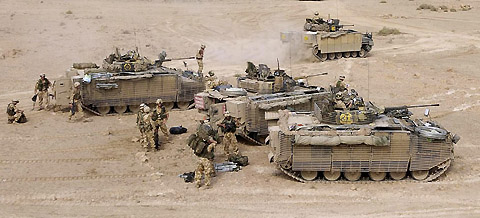[Editor's
note: Raytheon is a major contractor for the PMRF on Kauai
and is the owner the Solipsys facility between Kukui Grove
Mall and the Kamakahelei Middle School. A terrible location
for a facility that can function as a war room for Pacific
military operations.
Contractor had competitive advantage
by Adam Ciralsky, Lisa Myers 0n 6 September 2006
for NBC
News
Earlier this year, the U.S. Army awarded one of its favored
defense contractors, Raytheon, a $70 million contract to
develop a new system to combat rocket-propelled grenades
(RPGs), which have killed nearly 40 Americans in Afghanistan
and more than 130 in Iraq.
The Army insists that Raytheon won the contract fair and
square based on its “systems engineering expertise
and the discipline which they used in analyzing requirements,
threats and potential solutions.”
But an NBC News investigation of the contract selection
process reveals that at almost every turn, Raytheon was
given a significant competitive advantage over other defense
contractors, including an Israeli firm whose system was
extensively tested and found to be highly effective.
When contacted by NBC News about this matter, Raytheon said
it was not authorized to speak about how its contract was
awarded and instead referred all questions to the Army.
Raytheon’s contract is a small but important part
of the Army’s massive modernization program called
the Future Combat System (FCS), which has been under fire
in Congress on account of ballooning costs and what the
U.S. Government Accountability Office [link
to PDF report] found are worrisome procurement practices
that allow weapons manufacturers to effectively tell the
Army which weapons to buy.
The testing
Last year, the Army planned to test competing RPG defense
systems in what officials refer to as a "shoot-off
rodeo." At the time, Raytheon’s system was still
on the drawing board, and the Army opted to cancel the test.
In a statement to NBC News, the Army explained that the
cancellation was “primarily because of concerns related
to cost, supportability, practicality and fairness.”
But Pentagon officials involved in past shoot-offs say money
should not have been a factor since defense contractors,
not the Army, normally shoulder the cost of system vs. system
competitions.After canceling the shoot-off, the Army chose
to conduct what it called a “traditional source selection.”
We asked Col. Donald Kotchman, who heads the Army’s
effort to field an RPG defense system, about that process.
Lisa Myers: Was the Raytheon system tested
by the Pentagon?
Col. Donald Kotchman: The Army did not
specifically test the Raytheon system.
Instead, Raytheon tested its own system this February.
Myers: How well did the Raytheon system
do in its own testing?
Kotchman: I don't have that information.
Myers: Were there any Pentagon officials
present for the Raytheon testing?
Kotchman: I do not know.Video obtained
by NBC News shows that Raytheon’s system was not tested
under the most trying of conditions. It was mounted on a
test stand, not on a moving vehicle.
By contrast, a different Pentagon division, the Office of
Force Transformation (OFT) tested a competing Israeli system
— called Trophy — and found it at least 98 percent
effective against RPGs in near-battlefield conditions.
A number of senior Army officials were supposed to attend
those March 2006 tests but canceled.
In a statement, the Army said it does “not know who
was invited, who declined to attend, and why they did or
did not attend the demo.”
But an e-mail obtained by NBC News provides some insight.
In it, a senior Army official writes that the Army “just
awarded a contract to Raytheon” and wanted to “focus
all efforts toward supporting the fielding of the Raytheon
... solution.” Accordingly, the official went on to
say, “I don’t want anyone to think I’m
supporting [Trophy].”
Nevertheless, OFT officials were so impressed with Trophy’s
performance that they decided to buy several systems —
which cost $300,000-$400,000 each — for battlefield
trials on Stryker armored vehicles in Iraq next year. That
plan was eventually scuttled by the Army.
The selection team
In May, a technical team was chosen and given the task of
evaluating competing RPG defense systems. But here again,
Raytheon had a leg up.
Myers: Do you know how many of the 21-person
technical team worked for Raytheon?
Kotchman: To the best of my knowledge,
none.
Army documents obtained by NBC News, however, reveal that
nine of the 21 technical experts — as well as all
the administrative personnel — were from Raytheon.
The team ultimately concluded that of the seven RPG defense
systems examined, Raytheon’s was “the clear
winner.”
Raytheon’s “Quick Kill” solution —
which the Army concedes will not be fielded before 2011
at the earliest — won out over Trophy, the Israeli
system championed by the Pentagon’s Office of Force
Transformation.
Myers: It appears as though Raytheon was
allowed to select itself.
Kotchman: I don’t know that to be
a fact, and so I really can't comment on it.
The Army later told NBC News that, its own document notwithstanding,
the technical team actually consisted of 30 people plus
two administrative assistants and that a total of eight
people were from Raytheon.
“That sure doesn't look like an objective panel to
me,” says Phil Coyle, a former principal adviser to
the secretary of defense on weapons testing and evaluation.
“It just doesn't pass the ho-ho test when you have
that many people from one company on the selection panel
and then that company is the one that's chosen.”
Myers: Pentagon officials we spoke to said
that the Army, quote, cooked the books on this.
Kotchman: I don’t know the basis
of their assertion that the books were cooked and so ...
I can’t confirm that.
Recently, the Senate entered the fray and in what congressional
officials say was a slap at the Army, ordered Secretary
of Defense Donald Rumsfeld to put together a new, independent
evaluation of all RPG defense systems, foreign and domestic.
|
